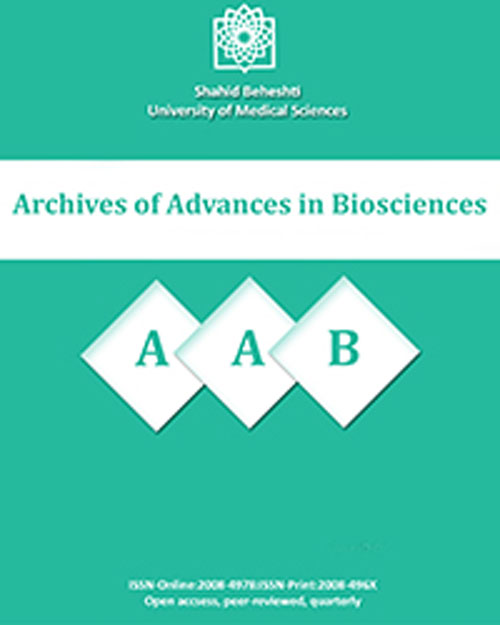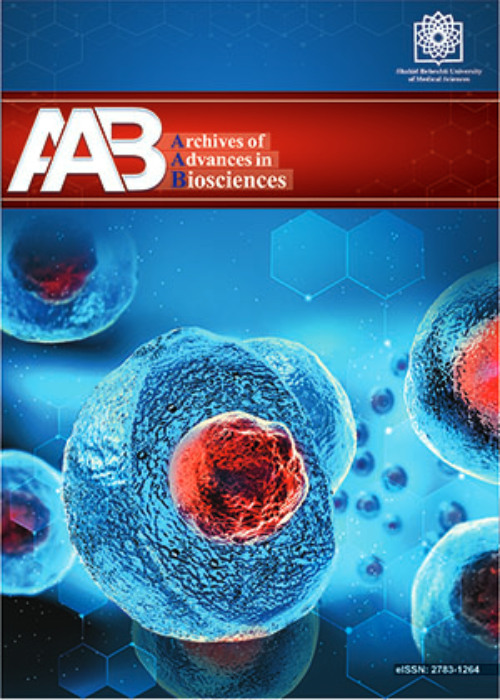فهرست مطالب

Archives of Advances in Biosciences
Volume:10 Issue: 4, Autumn 2019
- تاریخ انتشار: 1398/07/22
- تعداد عناوین: 8
-
-
Pages 1-14Introduction
The current study sought to investigate the impact of linguistic modification of medical textbooks on reading comprehension ability of medical students and their attitude towards text simplification.
Materials and Methods150 male and female medical students coming from Shahid Beheshti University of Medical Sciences participated in this study. The homogeneity of the participants was attained through passing a placement test, followed by completing the pre-requisite and general English courses. For the purpose of modifying the texts, the framework proposed by Van Den Branden (2000) was adopted. Moreover, the questionnaire developed by Saito, Horwitz, and Garza (1999) called Foreign Language Reading Anxiety Scale (FLRAS) was used.
ResultsData analysis was conducted, using one-way analysis of variances (ANOVA). Concerning the major research question, analysis of the data indicated that there were significant differences between the participants’ performance on the four reading tests. Thus, the major null-hypothesis as “lexical modification, grammatical modification, and lexical and grammatical modification in comparison with no modification of input do not significantly affect the reading comprehension ability of Iranian medical students differently” was rejected. The last research question deals with medical students’ perceptions towards different types of input modifications
ConclusionThe overwhelming majority of the interviewees chose lexically and grammatically modified texts. However, “not modified text” was regarded as the most boring one. Also, the participants believed that grammatically modified texts were best for improving students’ work knowledge. Moreover, the interviewees mentioned that grammatically modified texts with fewer complicated structures were more straightforward for them.
Keywords: SLA, ESP, Text Modification, Reading Comprehension, Simplification, Psychological Attitude, Syntax, Lexicon -
Pages 15-21Introduction
Physical exercise has positive effects on stress-induced pain response, while chronic stress persuades a negative effect on cognitive functions. Depending on the nature, duration and intensity of the stressor, it can repress pain (stress-induced analgesia) or exacerbate pain (stress-induced hyperalgesia). Furthermore, beneficial effects of Harmane on stress processes have been reported in rodents. This study aimed to investigate the effects of Harmane and moderate physical activity (associated or not) on pain response in restraint stressed mice.
Materials and MethodsHarmane was injected intraperitoneally at doses of 0.1, 0.3 and 0.6 mg/kg, every other day until 28 days, and pain response of the adult NMRI mice was detected using the hot-plate test
ResultsThe results exhibited that Harmane, at all doses used, did not alter pain perception in mice; however, 3- but not 6 and 9-day restraint stress (3 hours per day) induced hyperalgesia per se. In addition, Harmane reduced hyperalgesia in 3-day stressed mice, while moderate treadmill running (10 m/min for 30 min/day, 5 day/week) caused hyperalgesia in 6- and 9-day stressed mice. Furthermore, the hyperalgesia induced by moderate treadmill running in 9-day stressed mice restored by Harmane.
ConclusionThe findings indicated that Harmane has a protective effect on hyperalgesia induced by stress per se or potentiated effect of moderate treadmill running in stressed mice.
Keywords: Harmane, Restraint stress, Treadmill running, Pain, Mice -
Pages 22-30Introduction
Scintigraphy of renal system with radiopharmaceuticals extracts provides us with essential information as to assist the diagnosis and management of patients. In this research, effective doses of human’s organs due to gamma-rays of 99mTc-DTPA are estimated using the animal dissection data.
Materials and MethodsIn this study, the human absorbed and effective doses from 99mTc-DTPA are obtained from animal organs data, using medical internal radiation dosimetry (MIRD) method and MCNP simulation code. In each stage, three mice were injected and sacrificed, and then their organs were dissected and counted by well detector.
ResultsThe results of MIRD and MCNP simulation code indicated that the two mentioned methods are in agreement. Also, kidney (1.23E-03mGy/MBq), spleen (2.81E-03 mGy/MBq) and heart (2.75E-03 mGy/MBq) absorbed the most gamma dose compared to the other organs.
ConclusionAccording to the results and comparison with ICRP data, animal dissection model can be a useful tool for internal absorbed dose estimation of renal radiopharmaceuticals.
Keywords: MCNP simulation code, MIRD method, 99mTc- DTPA, Effective dose -
Pages 31-40Introduction
Firefighters are exposed to variety of stressors. Job related factors and shift-work system are the main stressors among Iranian firefighters. It seems necessary to study these related factors. Therefore, the present study aimed to find out what dimensions of job stress are associated with 24-hour shift-work schedule of firefighters.
Materials and MethodsAfter studying the validity and reliability of Persian version of NIOSH Generic Job Stress Questionnaire, 228 firefighters completed it, together with the validated version of the Survey of Shift-worker (SOS) questionnaire. The Spearman, Chi 2, Mann-Whitney and ANOVA statistical analysis were conducted through SPSS 18.
ResultsResults showed that some undesirable effects of Shiftwork in more than 60% of firefighters are medium to high. There was a significant relationship between variables of shiftwork (sleep disorders, the undesirable effects of shiftwork) and the variables of job stress (ambiguity in job future, workload, physical environment, job control, employment opportunities, non-work activities, social support from bosses, spouse, friends, relatives, subjective demands, role incompatibility, role ambiguity and job satisfaction).
ConclusionThe present study shows that adverse effects of 24-Hour Shiftwork and occupational stress largely interact with each other. Therefore, it could be concluded that job stress could be moderated or reduced and job satisfaction could concurrently be increased through focusing on the roots of occupational stress from the perspective of shiftwork systems.
Keywords: Firefighter, Job satisfaction, NIOSH Generic Job Stress Questionnaire (NGJSQ), Occupational Stress, Survey of Shift workers’ questionnaire (SOS) -
Pages 41-49Introduction
Mesenchymal stem cells (MSCs) have high potential in regenerative medicine based on their renewal properties and multilinearity differentiation capacity. MSCs have the ability to differentiate to osteoblasts, adipocytes, chondrocytes, cardiomyocytes, nerve cells, and fibroblasts. These cells have many sources such as bone marrow, umbilical cord blood, and amniotic membrane. Amniotic membrane is a postnatal organ, which does not require an invasive method for procurement. The immunomodulatory properties of MSCs make these cells the primary choice for allotransplantation and xenotransplantation.
Materials and MethodsIn this study, MSCs were isolated from the amniotic membrane, and their surface markers were identified using flow cytometry. The cells were differentiated to osteoblasts, adipocytes and cardiomyocytes using differentiation medium. GAP-43 and α-actin were studied with immunofluorescence and the expressions of related genes (GATA-4 and C-TNT) were assayed by real-time polymerase chain reaction.
ResultsThe results confirmed the differentiation of MCS to cardiomyocytes. The expression level of GATA-4 and C-TNT was higher than that of the control. The results of the present study suggested that differentiated human amniotic MSC possessed some characteristics of cardiomyocytes.
ConclusionTherefore, according to the results, the amniotic membrane is a suitable source of mesenchymal cells for differentiation into cardiomyocyte cells.
Keywords: Amniotic membrane, Cardiomyocyte, Mesenchymal stem cells, GATA-4, C-TNT, GAP-43, α-actin -
Pages 50-63Introduction
Nuclear factor, erythroid-derived 2, -like2 (Nrf2) and Nuclear erythroid 2-related factor 1 (Nrf1) stand as two important regulators of antioxidant defense system.
Materials and MethodsSmall interfering RNA (siRNA) targeting Nrf1 and Nrf2 (Nrf1&2) was injected in dorsal third ventricle of adult male albino Wistar rats. Anxiety-related behaviors and protein level of mitochondrial biogenesis, apoptotic marker factors and also electron transport chain (ETC), Citrate synthase (CS) and Malate dehydrogenase (MDH) enzymes activity in three brain regions: hippocampus, prefrontal cortex, and amygdala were evaluated.
ResultsNrf1&2-silenced rats induced anxiety-like behaviors compared to the control group. The level of peroxisome proliferator-activated receptor gamma coactivator 1-alpha (PGC-1a) protein increased in those three regions. Although Nrf1&2-silencing decreased MDH activity in hippocampus and prefrontal cortex, the activity of CS was increased in all three mentioned areas. However, Nrf1&2 silencing had no effect in complex I and II-III activity, but complex IV activity was increased, particularly in amygdala. Furthermore, Bax/Bcl2 ratio and cleavage of caspase-3 was increased in all mentioned areas of the brain in Nrf1&2-silenced group.
ConclusionIn conclusion, the presented data evaluated the complexity of mitochondrial functions and Nrf1 and Nrf2 in rat’s brain and points to mitochondrial crucial role in oxidative stress, energy metabolism, and behavior.
Keywords: Anxiety, Nrf1, Nrf2, siRNA, Apoptosis -
Pages 64-74Introduction
Tobacco when consumed in various forms have resulted in carcinogenic impact in oral cavity. Another risk factor is human papillomavirus, which is also closely associated with benign and malignant oral lesions. Therefore, the present study has been carried out to evaluate the immunohistochemical expression and distribution of p16INK4a antibody in oral squamous cell carcinoma and to correlate the association of human papilloma virus in patients with and without tobacco consumption.
Materials and MethodsAs the tongue and buccal mucosa remains the most common site for the patients affected with papilloma virus related tumors and oral squamous cell carcinoma, p16 expression has been evaluated in patients who consume tobacco (with habits) and patients who never consumed tobacco (without habits).
ResultsIn the present study, out of 60 samples, 73 % are males and 27 % are females and out of 30 samples (patients with tobacco habits) 73.3 % patients have the habit of pan chewing and 26.7 % have the habit of smoking. When the buccal mucosa and tongue of patients affected with oral squamous cell carcinoma were compared, expression of p16 didn’t show any significant difference in relation to site. The results showed that p16 expression was observed in all the groups, irrespective of patient’s intake of tobacco.
ConclusionIt can be concluded that tobacco is a major risk factor for oral carcinogenesis and human papilloma virus can act as an independent risk factor or synergistic factor with tobacco in the development of oral cancer.
Keywords: Tobacco Chewing, Smoking, Oral Squamous Cell Carcinoma, Buccal Mucosa, Human Papilloma Virus -
Pages 75-81Context
The natural crises national information system (NISNC) has a key role in promoting natural crisis management by analyzing and understanding the situation, managing and allocating the resources, coordinating actions and supporting of decision making and exchanging of information. The purpose of this paper is to examine the NISNC general and technical characteristics and functional capabilities in Germany, the Netherlands, Romania, and Turkey. Evidence Acquisition: This comparative study was conducted using databases like Google Scholar, Science Direct, PubMed and Scopus in the period from 2000 to 2017. The following featured were under the focus: being nationalized and computerized and availability of information. From among the 41 available studies, 24 were examined among which 12 belonged to Germany, 6 to the Netherlands, 3 to Romania and 3 to Turkey. Finally, the information obtained from different countries was compared on the basis of comparative tables.
ResultsIn all countries, the Interior Ministry was in charge of NISNC and NISNC is used in the entire cycle of crisis management (the Netherlands is used only in the reaction phase). This system has a modular design, distributed database, and mirror server. Synchronization allows the data recording in a system gets registered in other systems. NISNC is designed for static and dynamic data collection, with offline access allowed only in the Netherlands. The most common functional capabilities of the NISNC in selected countries were resource management, communication and reporting, status management and geographic information system.
ConclusionNISNC leads to the improvement of cooperation, information exchange and coordination in the management of natural crises through providing methods, terminology, information formats, and standard operating procedures.
Keywords: crises, natural crisis, crisis management, information system, national information system


